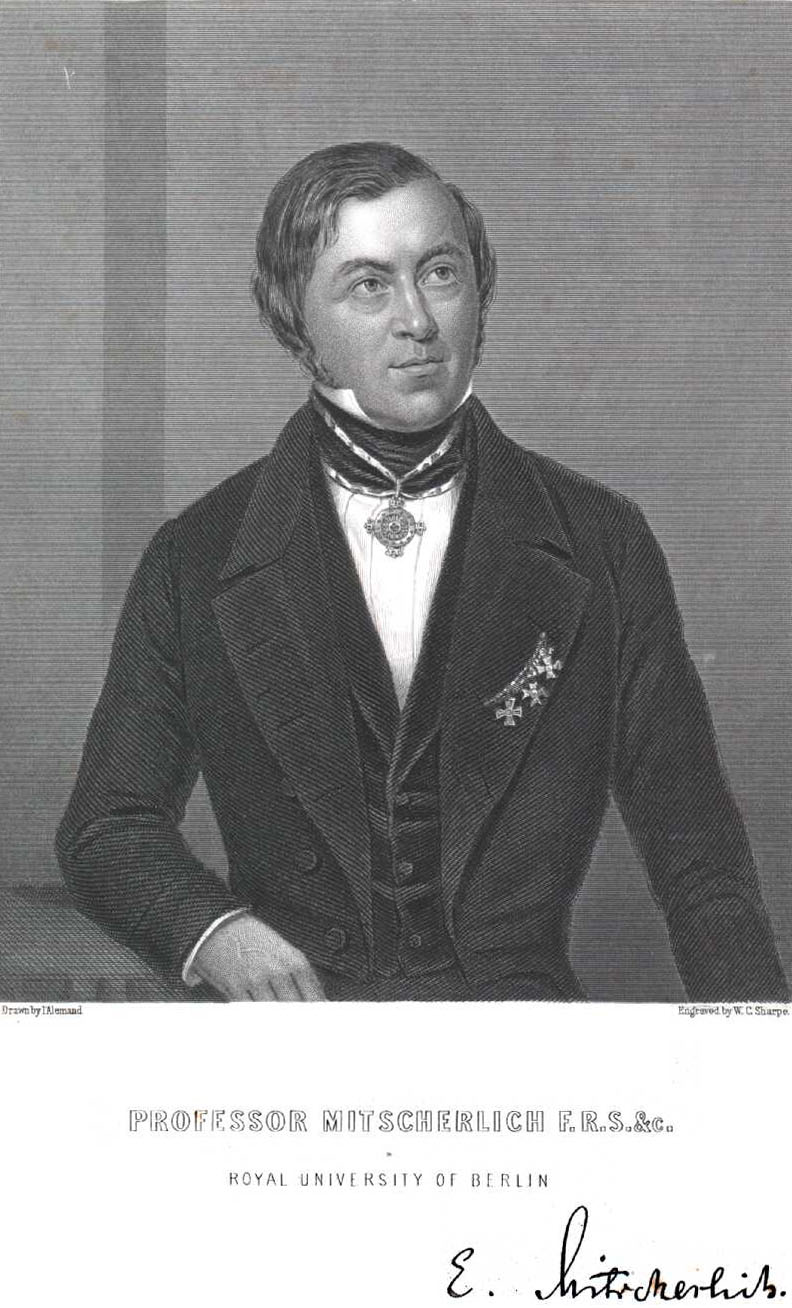- Eilhard Mitscherlich
Infobox_Scientist
name = Eilhard Mitscherlich
|200px
image_width = 200px
caption = Eilhard Mitscherlich (1794-1863)
birth_date = birth date|1794|1|7|df=y
birth_place = Neuende, Jever
death_date = death date and age|1863|8|28|1794|1|7|df=y
death_place =Schöneberg ,Prussia
residence =Germany
nationality = German
field =Chemist
work_institution = University of Berlin
alma_mater =University of Göttingen University of BerlinUniversity of Stockholm
doctoral_advisor =Friedrich Stromeyer
doctoral_students =Heinrich Gustav Magnus
known_for =Selenic acid ismorphism
prizes =
religion =
footnotes =Eilhard Mitscherlich (7 January 1794 – 28 August 1863) was a German
chemist , who is perhaps best remembered today for his law of isomorphism (1819), which states that compounds crystallizing together probably have similar structures and compositions. This relationship was used by Berzelius in early attempts to assign relative masses to the elements.Early life and work
Mitscherlich was born at Neuende in the
Lordship of Jever , where his father was pastor. His uncle,Christoph Wilhelm Mitscherlich (1760-1854), professor at Göttingen, was in his day a celebrated scholar. He was educated at Jever under the historianFriedrich Christoph Schlosser , when he went to Heidelberg in 1811, and devoted himself tophilology , giving special attention to thePersian language . In 1813 he went toParis to obtain permission to join the embassy whichNapoleon I of France was sending to Persia.The events of 1814 put an end to this, and Mitscherlich resolved to study
medicine in order that he might enjoy that freedom of travel usually allowed in the East to physicians. He began at Göttingen with the study ofchemistry , and this so arrested his attention that he gave up the journey to Persia. From his Gottingen days dates the treatise on certain parts of Eurasian history, compiled from manuscripts in the university library and published in Persian andLatin in 1814, under the title "Mirchondi historia Thaheridarum historicis nostris hucusque incognitorum Persiae principum".In 1818 Mitscherlich went to Berlin and worked in the laboratory of
Heinrich Friedrich Link (1767-1851). There he made analyses ofphosphate s andphosphite s,arsenate s andarsenite s, confirming the conclusions ofJöns Jakob Berzelius as to their composition; and his observation that corresponding phosphates and arsenatescrystal lize in the same form was the germ from which grew the theory of isomorphism, which he communicated to the Berlin Academy in December 1819. In that year Berzelius suggested Mitscherlich to the ministerKarl vom Stein zum Altenstein as successor toMartin Heinrich Klaproth at Berlin. Altenstein did not immediately carry out this proposal, but he obtained for Mitscherlich a government grant to enable him to continue his studies in Berzelius' laboratory at Stockholm. He returned to Berlin in 1821, and in the summer of 1822 he delivered his first lecture as extraordinary professor of chemistry in the university, where in 1825 he was appointed ordinary professor.Isomorphism
In the course of investigating slight differences discovered by
William Hyde Wollaston in the angles of the rhombohedra of thecarbonate s isomorphous with calc-spar, Mitscherlich observed that the angle in the case of calc-spar varied with the temperature. On extending this inquiry to otheraelotropic crystals, he observed a similar variation, and was thus led, in 1825, to the discovery that aelotropic crystals, when heated, expand unequally in the direction of dissimilar axes. In the following year he discovered the change, produced by change of temperature, in the direction of the optic axes ofselenite . His investigation, also in 1826, of the two crystalline modifications ofsulphur threw much light on the fact that the twomineral s calc-spar andaragonite have the same composition but different crystalline forms, a property which Mitscherlich called isomorphism. [cite journal | author=S. I. Morrow | title= One Hundred and Fifty Years of Isomorphism | journal = Journal of Chemical Education | year = 1969 | volume = 46 | pages=580–584 ] [cite journal | author = (Anonymous) | title = Eilhard Mitscherlich (Obituary)| journal = Proceedings of the Royal Society of London | year = 1864 | volume = 13 | pages = ix-xvi ]Later work and last years
In 1833 Mitscherlich made a series of careful determinations of the vapour densities of a large number of volatile substances, confirming the law of
Gay-Lussac . He obtainedselenic acid in 1827 and showed that itssalt s are isomorphous with thesulphate s, while a few years later he proved that the same thing is true of themanganate s and the sulphates, and of thepermanganate s and theperchlorate s. He investigated the relation ofbenzene tobenzoic acid and to other derivatives. In 1829-1830 he published his "Lehrbuch der Chemie", which embodied many original observations. His interest inmineralogy led him to study thegeology of volcanic regions, and he made frequent visits to theEifel with a view to the discovery of a theory of volcanic action. He did not, however, publish any papers on the subject, though after his death his notes were arranged and published by Dr. J. L. A. Roth in the Memoirs of the Berlin Academy (1866).In December 1861 symptoms of
heart disease made their appearance, but Mitscherlich was able to carry on his academic work until December 1862.He died at
Schöneberg near Berlin in 1863 and was buried in the St Matthäus Kirchhof Cemetery in [chöneberg close to the (eventual) gravesites ofGustav Kirchhoff andLeopold Kronecker .Papers
Mitscherlich's published papers are chiefly to be found in the Ablsendlungen of the Berlin Academy, in Poggendorff's "Annalen", and in the "Annales de chemie et tie physique".
The fourth edition of Mitscherlich's "Lehrbuch der Chemie" was published in 1844-1847; a fifth was begun in 1855, but was never completed.
References
Further reading
* "Eilhard Mitscherlich: Prince of Prussian Chemistry" by Hans-Werner Scuhtt, 1997, ISBN 0-8412-3345-4
* [http://books.google.com/books?id=a-oAAAAAYAAJ&pg=PP13&lpg=PP13&dq=hittorf+obituary&source=web&ots=aN4pgaUold&sig=JFTs_ki78H-LWBkSfM3oF_ikzxo#PRA1-PA527,M1 Obituary] of Eilhard Mitscherlich in "Proceedings of the Royal Society of London", volume XIII, 1864 (pages ix - xvi, near the end of the volume)
*Persondata
NAME= Mitscherlich, Eilhard
ALTERNATIVE NAMES=
SHORT DESCRIPTION= Germanchemist
DATE OF BIRTH= 7 January 1794
PLACE OF BIRTH= Neuende,Lordship of Jever
DATE OF DEATH= 28 August 1863
PLACE OF DEATH= Schadenberg,Prussia
Wikimedia Foundation. 2010.
